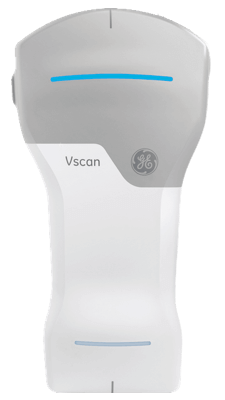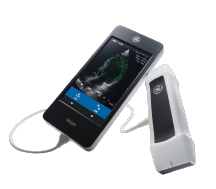When it comes to the best quality patient care, the physical exam is a fundamental factor. Providers glean a great deal of information this way, but using handheld ultrasound to visualize non-visible parts of the body might be a powerful clinical complement.
In many cases, having handheld ultrasound available might also be the key to accelerated patient care and accurate diagnoses. And, when time is of the essence, point-of-care ultrasound (PoCUS) may be the tool that speeds up your diagnostic capabilities.
Ultimately, using PoCUS, such as GE’s Vscan Extend™, increases not only your confidence with your diagnosis, but your patient’s comfort with the care you provide.
Inspiring Confidence
When a patient presents with a suspected problem, such as right upper quadrant or flank pain, making a timely diagnosis may be critical. Alongside a physical exam, PoCUS lets you focus immediately on the problem area and see what’s invisible to the naked eye, giving you greater confidence in identifying the cause of the symptoms.
In fact, point-of-care ultrasound could increase how detailed your exam can be, adding valuable information to the patient’s electronic health record. In a short amount of time, PoCUS may capture multiple clear images to give you a more robust picture. According to the concluding findings of a 2016 report from The World Book of Family Medicine, “because of a significant number of advantages, ultrasonography should be a diagnosis tool” used with a stethoscope in medical offices.
If needed, this level of detail lets you refer your patients for the right test or diagnostic treatment, reducing the likelihood they will go through unnecessary doctor visits or unneeded additional imaging.
Saving Time
PoCUS images may also help you save time whether you’re an emergency department (ED) physician or a general practitioner.
In the ED, having access to a handheld ultrasound device may determine if and how you triage your patients. For example, if an individual has symptoms of cardiac distress, PoCUS may reveal information at the bedside in real time.
A PoCUS exam may also pave the way for rapid diagnosis during a regular doctor’s visit. During an appointment, you may make an immediate decision whether your patient needs to see a specialist or be hospitalized. Not having to wait for another provider’s analysis may fast-track needed therapy and reduce any stress patients might have about their symptoms.
Shortening Diagnosis Time
As you use PoCUS more often and fine-tune your skills, you’re likely to become more confident in your findings. Over time, it’s possible that you’ll be able to render your bedside diagnoses and offer guidance more quickly.
A 2011 European Journal of Echocardiography study tested the diagnostic efficiency of PoCUS and high-end echocardiography and concluded that “pocket-sized echocardiographic examinations of approximately four-minute length, performed at the bedside by experts, offers reliable assessment of cardiac structures, the pleural space and the large abdominal vessels.”
Improving Relationships
As a hand-held device, PoCUS gives you the opportunity to have more face time with your patients. In many cases, they watch as you conduct the exams and can ask questions. Getting real-time information from ultrasound images may increase the patient’s confidence in your diagnosis and the treatment you’ll prescribe. For example, PoCUS at the bedside may provide a pregnant woman with the immediate visual confirmation that her unborn baby is healthy.
Additionally, according to a 2018 Annals of Internal Medicine study, PoCUS may also offer high ultrasound imaging quality, and the authors concluded that they “believe that use of ultrasound by hospitalists will continue to modernize the bedside evaluation and streamline the diagnostic process.” Bedside testing may lead to decreased lengths of stay, a reduction in resource utilization and lower costs.
PoCUS vs. Other Modalities
In many instances, PoCUS may provide better ultrasound image quality than the other modalities you employ with your patients. For example, according to the conclusions of a 2013 Clinical Cardiology study, “the pocket-sized (portable transthoracic echocardiography) provides accurate detection of cardiac structural and functional abnormalities beyond the ECG.” These findings may boost your confidence that you’ll catch a problem earlier.
In addition, research has also shown PoCUS is a strong alternative to chest X-ray when diagnosing pericardial (PE) and pleural effusions (PLE). A 2015 Scandanavian Cardiovascular Journal article that observed nurses using ultrasound concluded that “Cardiac nurses were able to obtain reliable measurements and quantification of both PE and PLE bedside by focused ultrasound.”
Overall, in today’s healthcare environment, PoCUS may play a significant role in providing additional clues during physical exams to make a diagnosis. By employing PoCUS, you may be able to gather these images much faster than you possibly could with other options. And, as you become more proficient with the hand-held technology, you may become more confident with your real-time diagnosis, potentially improving patient care.




